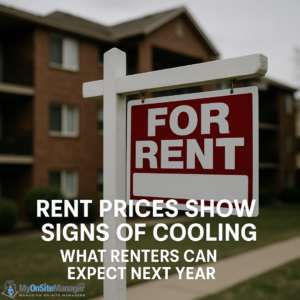After years of steady, sometimes brutal, increases in rent prices across the U.S., there’s finally a shift underway — and it’s giving hope to renters everywhere. According to The National Desk, the rental market is showing clear signs of slowing, with forecasts pointing toward a more moderate pace of rent growth in the coming year.
This shift, while not an overnight solution to housing affordability challenges, could mark a turning point for tenants who have long struggled to keep up with ballooning costs. So, what’s behind this cooling trend, and what can renters realistically expect heading into next year? Let’s break it down.
The Perfect Storm That Drove Rent Prices Up
To understand why this slowdown is significant, we need to look back at the forces that created today’s rent crisis. Over the past several years, multiple factors have combined to push rents to record highs:
-
Limited Housing Supply: New housing construction lagged behind demand for years, particularly in high-demand cities. This left renters fighting over a limited number of available units.
-
Pandemic Disruptions: COVID-19 caused construction delays, labor shortages, and supply chain issues, further choking the supply of new housing. Eviction moratoriums also shifted rental market dynamics in unpredictable ways.
-
Soaring Demand: As homeownership became less accessible due to rising prices and tight inventory, more people stayed in or returned to the rental market, putting extra pressure on available rentals.
-
Rising Inflation: Landlords faced higher costs for taxes, insurance, maintenance, and utilities, often passing those costs on to tenants in the form of higher rents.
For many renters, this meant stretching budgets to the limit, sacrificing savings, or even moving farther away from work or family just to secure affordable housing.
Why the Market Is Finally Cooling
Now, the tides may be turning — and experts point to several major shifts:
New Construction Flooding the Market
In recent years, developers accelerated efforts to build more apartment complexes, townhouses, and condo units. While construction delays slowed progress during the pandemic, many of those new units are now hitting the market. This sudden increase in supply is helping to rebalance the market, reducing competition and putting downward pressure on rents, especially in larger metro areas.
Higher Interest Rates Reshaping Housing Demand
The Federal Reserve’s series of interest rate hikes aimed at curbing inflation have also made homeownership more expensive, with higher mortgage rates pushing some would-be buyers to remain renters. However, at the same time, these rates have cooled overall housing market activity, reducing speculative investment in rentals and stabilizing prices.
Shifting Demographics and Preferences
Some renters are moving back into cities after pandemic-era relocations to suburban or rural areas, while others are doubling up with roommates or family to save money. These changing dynamics are reshaping rental demand, with some markets seeing less pressure than before.
What to Expect in 2025
While no one expects rents to fall dramatically across the board, the outlook for 2025 suggests a much slower pace of rent increases compared to the last few years. Here’s what that means in practical terms:
In Cities with Oversupply
Urban centers where developers have overbuilt — like parts of Dallas, Atlanta, and Denver — could see rent growth stall or even decline slightly as landlords compete to fill units. Tenants may benefit from move-in specials, discounts, or more flexible lease terms.
In High-Demand, Low-Supply Markets
In cities like New York, San Francisco, or Miami, where population growth outpaces new construction, rents may continue rising but at a slower rate. Renters should still be prepared for high prices but may find fewer bidding wars or extreme price hikes.
In Suburban and Secondary Markets
Some suburban areas that saw surging demand during the pandemic might cool as renters return to urban living. This could create new opportunities for deals in areas that were previously overheated.
How Renters Can Take Advantage
With the market shifting, renters should be proactive:
Negotiate Your Lease Renewal
If your lease is coming up, don’t automatically accept a rent increase. Ask your landlord if they’re willing to keep your rent flat or offer incentives. Many landlords would rather retain a reliable tenant than face a vacancy.
Explore New Listings
With more available units on the market, now may be a good time to compare your current rental with others in the area. You may find better deals, upgraded amenities, or more flexible terms.
Stay Informed on Local Trends
Not all markets will cool equally. Follow local rental market reports and stay connected to neighborhood groups or housing advocates to understand what’s happening in your area.
Consider Longer Leases or Lock-In Deals
If you find a good deal, consider negotiating a longer lease term to lock in today’s prices before future increases return.
What This Doesn’t Mean (Yet)
While the cooling trend is positive, it’s important to be realistic. Rent relief won’t happen overnight, and many households remain rent-burdened, spending over 30% (or even 50%) of their income on housing. Cities with long-standing housing shortages will still face structural challenges, and broader economic shifts could affect future rent trends.
That’s why it’s crucial for policymakers, developers, and communities to continue focusing on long-term solutions: building more affordable housing, reforming zoning regulations, and providing renter protections.
Final Takeaway
The U.S. rental market is entering a new phase — one where tenants may finally gain a bit more breathing room after years of record-breaking price increases. Whether you’re renewing a lease or searching for a new home, staying informed and proactive will help you take advantage of this shifting landscape.
Keep an eye on your local market, ask questions, and don’t be afraid to negotiate. The balance of power between landlords and renters is starting to shift — and smart renters can position themselves for a more stable housing future.
Source:
The National Desk – Rent prices showing signs of slowing, expected to moderate next year

